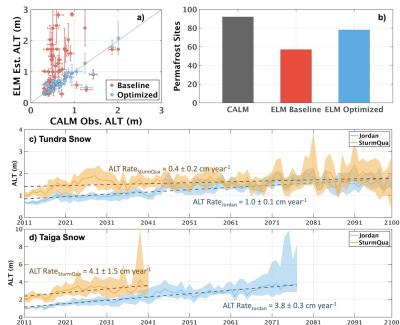Peat Soils and Snow Schemes Mutually Impact Permafrost Simulations
Permafrost is soil that stays below 0°C for at least two consecutive years. Climate warming is causing it to thaw, releasing greenhouse gases and altering the Arctic landscape. The thermal buffering effects of snow and peat soils, with their low thermal conductivity, influence permafrost stability. Many models overestimate the active layer thickness (ALT) above permafrost due to inaccurate representations of peat and snow insulation. Here, we examined the impacts of peat soil- and snow-related schemes that influence heat transfer through the soil and thus affect permafrost warming. The findings improved ELM-simulated ALT at over 100 permafrost sites across the pan-Arctic.
The research yielded a comprehensive assessment of the impacts of peat soils and snow schemes on predicted permafrost conditions. It also highlighted the importance of accurately representing both snow processes and peat soil profiles in land models to enhance permafrost simulations. With the enhanced simulations, scientists can better predict how permafrost will change in the future and its potential impacts on ecosystems and climate. This research contributes to understanding climate warming impacts on the Arctic region. It also helps inform future predictions of permafrost thaw, understand the large uncertainty with these predictions, and help decision-makers protect the Arctic.
Thawing permafrost can release large amounts of greenhouse gases, exacerbating global warming. Here, we used the E3SM Land Model (ELM) to simulate permafrost dynamics at more than 100 sites from the Circumpolar Active Layer Monitoring (CALM) network across the Arctic. We examined the effects of peat soil organic matter content profile, precipitation-phase (rain or snow) partitioning methods, snow compaction schemes, and snow thermal conductivity schemes on simulated soil temperature and active layer thickness (ALT). We compared these simulations with CALM measurements and significantly improved ELM-simulated site-level ALT via optimizing peat soil- and snow-related schemes used in the model. Our sensitivity analysis revealed that both peat soil organic matter density profiles and snow-related schemes significantly impact simulated soil temperature and ALT. For instance, the quadratic Sturm snow thermal conductivity scheme generally produced warmer soil temperatures and larger ALT compared to the other two schemes under both current and future climates. Notably, it predicted that Taiga sites would transition to a permafrost-free state approximately 36 years earlier than other snow thermal conductivity schemes. The study highlights the importance of accurately representing both snow-related processes and soil thermal properties in land models to enhance permafrost dynamics simulations. It is also helpful in understanding the uncertainty of model-projected future permafrost thaw.

